ISSN ONLINE(2320-9801) PRINT (2320-9798)
ISSN ONLINE(2320-9801) PRINT (2320-9798)
| MR.G.AYYAPAN1 Associate Professor, Dept. of IT, Bharath University, Chennai -600073 |
| Related article at Pubmed, Scholar Google |
Visit for more related articles at International Journal of Innovative Research in Computer and Communication Engineering
In this technological world, Learning has been made ease with of E-Learning. E-Learning is booming a wide in websites which leads to valuable learning. It is referred to the intentional use of networked information and communications technology in teaching and learning. Web-based E-Learning offers academics to raise maintenance-related knowledge and competence. E-Learning websites shows its tremendous growth in educational field and it should gratify all the pedagogical attributes. Pedagogy refers to the correct use of instructive strategies. The website that satisfies the Pedagogical attributes must be considered as the innovative E-Learning website. The website has to be checked with regard to its Learning objectives with the topic types as Knowledge, Attitude, and Skill, Meta-learning and Pedagogical methods with the topic types as Drill, Presentation, Tutorials, Gaming, and Demonstration using Pedagogical Attribute. Learning objectives and Pedagogical methods of Pedagogical attributes are very important in the web portal to give the E-Learning in more effective manner. The main aim of this paper is to make E-Learning websites booming in learning. This paper has made a study about the attributes of Pedagogical representation and a case study about how effective; the E-Learning has been made with “Education” column of ‘W3Schools’ web portal (online).
Keywords |
| E-Learning, Pedagogy, Web based learning. Instructor, Teaching |
INTRODUCTION |
| E-Learning comprises all forms of electronically supported learning and teaching. The information and communication systems, whether network or not, serve as specific media, which includes online learning, virtual learning, distributed learning, network and web based learning [1]. Primarily, they all refer to educational processes that utilize information and communications technology. It can be self-paced or instructor-led and includes media in the form of text, image, animation, streaming video and audio. In E-Learning, education is rapidly increasing and online doctoral programs have even developed at leading research universities. |
| E-learning offered several potential benefits over web-based learning: The ability to reach a wide audience instantaneously, Cost savings over classroom based training, Measurable results on take up and performance, the potential to create a community of E-learners. These are the challenges and benefits that make E-learning success. W3schools is a website for learners with an interest in web-based learning. The W3schools site is visited by web based learners who have more of an interest than the common learners. The site derives its name from the abbreviation for the World Wide Web; W3 is a numeronym of WWW. It is created and owned by Refsnes Data, a Norwegian family-owned software development and consulting company. The site largely consists of beginner's tutorials and references of the main subjects and languages. It's amazing how much information this website packs in a small place. You can even read previously published programming books here [3]. W3Schools is one of the most venerable and respected resources for online tutorials. W3 Schools is fabulous in that they contain up-to-date tutorials on any language that the learners want to learn. Along with these tutorials, W3 Schools enables learners to interact with various portions of the site, so they can practice what they are reading. |
| E-Learning should be achieved through the pedagogical attributes. It has to be implemented in the E-Learning websites. Thus, the e-learners and the facilitators can achieve ease in learning. |
| 1.1Classification of Pedagogical attributes |
| The concept of E-Learning has emerged only during past few years due to the exchange of data among the students, business organizations, government etc. In particular the concern on E-Learning has been increased due to the growth of internet. The review of E-Learning is done here. Pedagogical attributes [9] is classified into three categories, Learning Objectives, Pedagogical methods and Learning Objects. Each category has many Topic types like Knowledge, Attitude, and Skill, Meta-learning Etc. as shown in Table1. |
TABLE 1 |
| THE PEDAGOGICAL ATTRIBUTES |
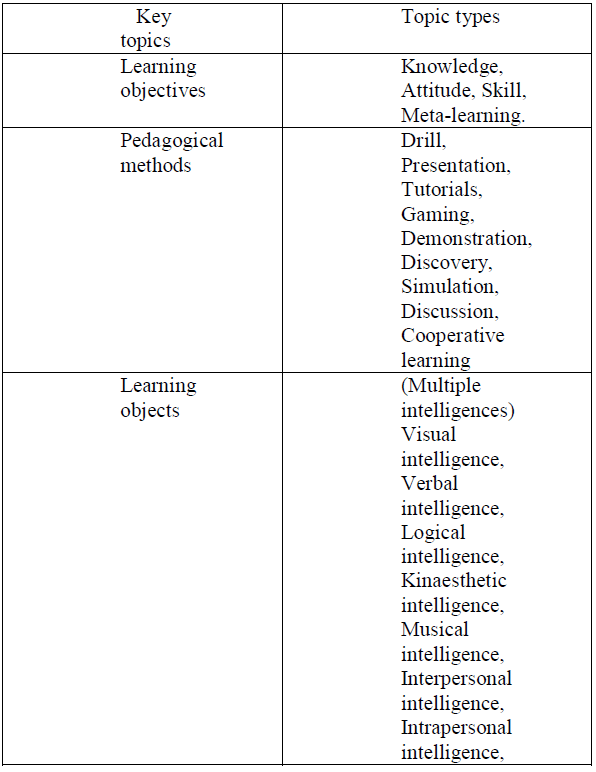 |
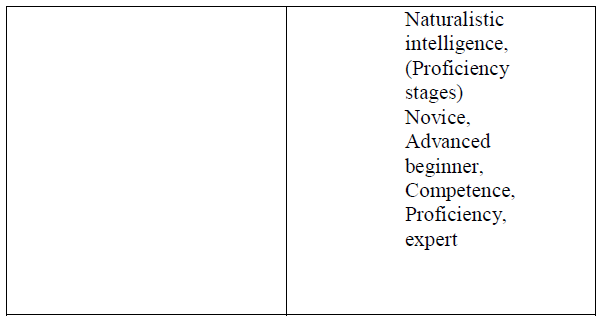 |
| Case study |
| Pedagogy, referred to as the correct use of instructive strategies. In correlation with those instructive strategies, the instructor's own philosophical beliefs of instruction are harbored and governed by the learner’s background knowledge and experience, situation, and environment, as well as learning goals set by the learner and facilitator [2]. |
| The benefits of e-learning are obvious in the current economic climate, especially in the educational field where releasing facilitators for traditional training is becoming increasingly difficult. Being able to provide an online training facility to our distribution channel, without the need to take facilitators out of the workplace, gives us a distinct advantage over our competitors. “W3Schools” has developed a platform that delivers on every aspect of our initial brief, further more their fresh approach to some of our initial ideas means they now have a training package that offers more than anything else within the learning programme. |
| The e-learning key topics are learning objectives and pedagogical methods. They were based upon type of the topic, topic associations and its occurrences [8]. The table 1 describes the learning objectives and pedagogical methods. |
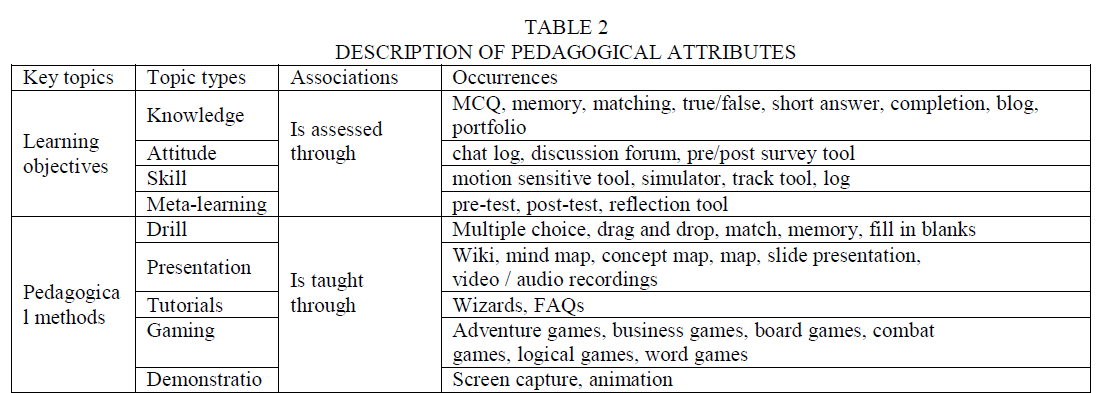 |
 |
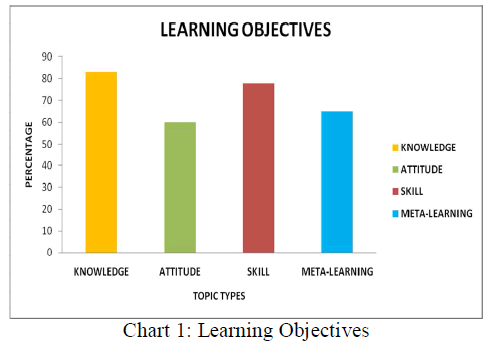 |
| Chart1 represents the learning objectives in which the knowledge is 83%, attitude is 60%, skill is 78% and the meta-learning is 65%. On an average of the topic types, which are knowledge, attitude, skill and meta-learning is measured as 72% from the feedback. |
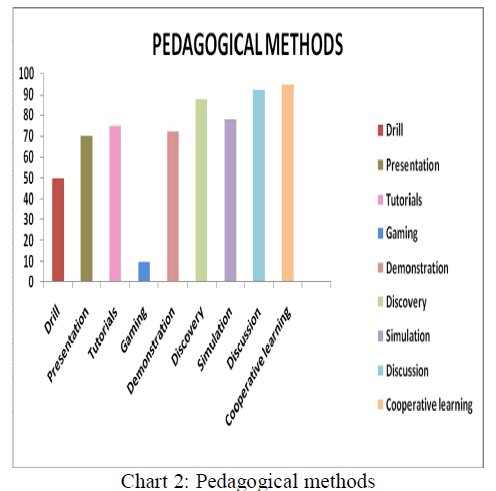 |
| Chart2 represents the Pedagogical methods in which the topic types has been observed through the factors of Drill, Presentation, Tutorials, Gaming, demonstration, Discovery, Simulation, Discussion, Cooperative learning. |
| From the above chart 2 we observe that the Drill - 50%, Presentation - 70%, Tutorials - 75%, Gaming - 10%, demonstration - 72%, Discovery - 88%, Simulation - 78%, Discussion - 92%, Cooperative learning - 95%. |
CONCLUSION |
| E-learning website is based on the axiom that the learning takes place anywhere, anytime. The skills for acquiring knowledge play a greater role in success than knowledge concepts. It is becoming increasingly prominent in educational websites. E-learning as a pedagogical issue has brought many benefits to learners. The pedagogical attribute develops a thick rapport between the learner and the facilitator. Among the most visible and valuable attributes of e-learning techniques and delivery is that they potentially give learners greater access to education, in comparison to traditional learning. The websites that are developed by satisfying all the attributes of the pedagogical methods is considered to be the best and also it shines well. The study on the “W3Schools” makes clear that more pedagogical attributes has been satisfied and it can include more depth in attributes like Attitude, Meta-learning, Drill, Presentation and Gaming. If the E-Learning websites satisfies all the pedagogical attributes which has been mentioned in this study, then it is considered as the admired E-Learning websites. Future study can lead to all the fields of the website, identification of lack of pedagogical attributes in the portal, suggestions to improve the E-learning websites can also be included. |
References |
|